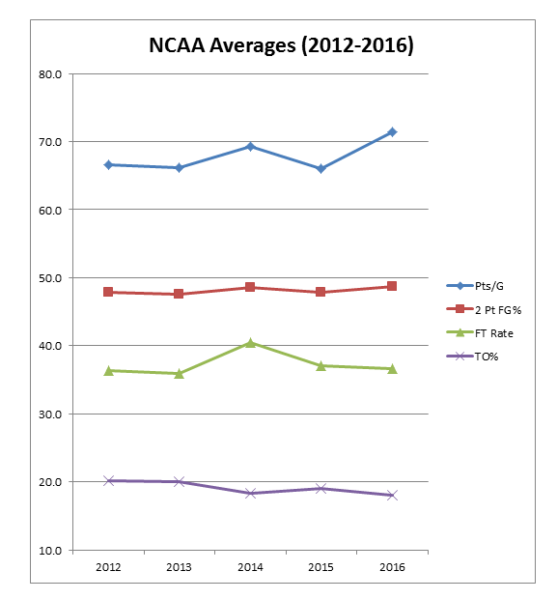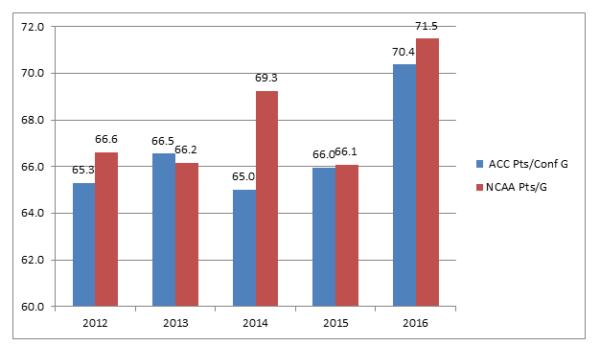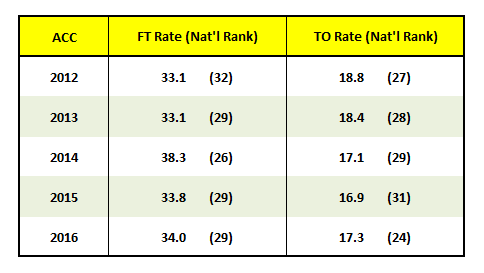Evaluating Last Season’s Rule Changes
Posted by Brad Jenkins (@bradjenk) on October 14th, 2016After a college basketball season in which overall scoring fell to its lowest point in the shot clock era, the NCAA Playing Rules Oversight Panel in 2015 approved a set of new rules and other modifications that were designed to increase the pace of action and increase overall scoring. Before we dive too deeply into the upcoming campaign, let’s evaluate the implementation of those rule changes by comparing some key metrics from last season against the four previous seasons.

There’s little doubt that college basketball benefited from last year’s rule changes. The average NCAA team scored 71.5 points per 40 minutes, an increase of 5.4 points over the prior year. This was a result of the wise decision to implement a comprehensive approach to implementation. Reducing the shot clock from 35 to 30 seconds was the most discussed change, but that alone didn’t account for the scoring bump. Offenses also got more efficient, rising from an average of 1.020 points per possession in 2014-15 to 1.036 last season. Credit for that improvement largely goes to officials for enforcing freedom of movement as well as to coaches and players for adapting to the new rules. The same cannot be said about the 2013-14 season, one in which the NCAA first tried to address declining offense. A focus that year on officiating led to more points but the uptick in scoring was mostly driven by a huge increase in free throw attempts (see chart above). It did nothing to make the game easier on the eyes, and it also correspondingly left us with a need for drastic changes because referees reverted back to previous norms the following season (2014-15).
We were also impressed that the panel was concerned with the length of games in real time. Again, the comprehensive approach worked — one fewer timeout per team; having certain team timeouts replace media breaks; shortening the time a coach is allowed to substitute for a disqualified player. It was also easy to see officials hustling everyone (including themselves) during clock stoppages — particularly after timeouts and before free throws — to get the ball back into play as soon as possible. Most TV games last season were completed in a two-hour window, something we hadn’t consistently seen in many years.
ACC offenses also benefited greatly from the changes, lagging behind the national scoring average by just over a point in conference games.

The thing that stands out the most in the table above is the disparity between ACC and NCAA scoring in the 2013-14 season. Remember, that was the season when there was a national scoring spike as a result of more foul shots taken. So what happened to the ACC that year?
The problem wasn’t with league offensive efficiency, which was above the national average; rather, scoring in the ACC was restricted by a massive drop in tempo. The league simply got much slower because of expansion, adding Notre Dame, Pittsburgh, and Syracuse and their snail’s pace tempos to the mix. Exchanging Maryland for Louisville the next season seemed to raise the overall tempo slightly. Interestingly, the ACC ranked dead last among all conferences with a pace of 66.4 possessions per league contest last year, but that number was still higher than the national average of the year before. Many might think that the slowest league in college basketball may not be very exciting, but ACC teams make up for its lack of tempo in a number of ways, including highly efficient offenses and lots of star power on both the floor and the sidelines.

The table above reveals two more reasons that the ACC plays an attractive brand of basketball. From a watchability standpoint, games that feature a lot of fouling and frequent turnovers can be difficult to endure. Luckily for conference fans, the league consistently ranks among the bottom conferences in both categories, relegating the especially sloppy play to the other leagues around the country.
Let’s hope that the improvements that we saw last season stick around. The precedent has been set that meaningful changes can work if everyone is on board with improving the game. As for the future, the NCAA should consider moving the three-point line back another foot and reducing another timeout. If there comes a time when the balance of the game starts to inequitably swing back to the offense, officials could easily fix that problem by appropriately calling palming violations. It may sound a bit old-school, but if we’re not going to allow the defender to put his hands on the dribbler, than we shouldn’t let the ball-handler execute the illegal move of stopping his dribble for a whole beat before moving somewhere else on the court. Balance is important to the game, so preserving a fair mixture of inside/outside play along with disallowing an unfair edge to either offense or defense, will maintain the great strides the college game has made.











































